Operational Risk Management in Banks: A Bibliometric Analysis and Opportunities for Future Research
Abstract
1. Introduction
2. Literature Review
2.1. Overview of Operational Risk Management in Banks
2.2. Overview of Bibliometric Studies
2.3. Research Gaps and Significance of the Study
3. Materials and Methods
3.1. Document Selection
- The downloading of R and RStudio;
- Exporting of the BIB file from Scopus;
- Exporting of the BIB file from Web of Science (WoS);
- The merging of BIB files to generate an XLSX file using RStudio (refer to Appendix A for the details of the code used);
- The uploading of the XLSX file to Biblioshiny (Bibliometrix’s interface) for performing analysis.
3.2. Bibliometric Analysis
- Trend Analysis: This analysis is useful to identify the patterns of literature growth and show if academicians have had more or reduced interest in a specific domain over this time span. The trend analysis was performed in this study for the period 2010 until March 2023.
- Citation Analysis: With the help of citation analysis, important research papers and key authors who have made significant contributions to the research domain are pinpointed. Increased citations indicated a higher interest in that subject matter by academicians (Mahadevan and Joshi 2021). The citation analysis has been used in the current study to identify the top documents.
- Important contributors: These would be the top authors, countries, journals, and affiliations. This is useful to identify key research done in this field and could possibly help in networking/collaborating for future research.
- Keyword frequency analysis: This analysis helps identify the most frequently used words by authors to depict their research.
- Bibliographic coupling: This technique is used to ascertain a similarity relationship between research papers. This technique is used as there are several common references (Khanra et al. 2021).
3.3. Network Visualization Analysis
- Analysis of co-occurrences of the keywords: It is performed by mapping the relationships between author keywords, which provides insight into the approach followed by academicians.
- Visual map of countries: This helps to understand the collaborations among several authors and countries. This enables the key clusters of countries that work together for the research to be reflected.
3.4. Content Analysis
- Analysis of themes: Various themes in the current domain of ORM in banks can be identified, and accordingly, further analysis could be performed.
- Future research direction: Analysis of the content of the various research articles can help identify future research areas, which can be a tremendous help to researchers in this domain.
4. Results and Findings
4.1. Descriptive Statistics
4.2. Analysis of Important Authors and Countries
4.3. Keyword Analysis
4.4. Bibliographic Coupling
4.5. Network Visualization Analysis
4.5.1. Visual Map of Co-Occurrences of Author Keywords
4.5.2. Visual Map of Countries Based on Analysis of Co-Authorship
4.6. Thematic Analysis
- Analysis of various operational risks and ways to mitigate such risks;
- Operational risk management regulations;
- Operational risk modeling.
5. Discussion
5.1. Analysis of Trends and Significant Contributors to This Research Field
5.2. Analysis of the Most Relevant and Important Keywords in This Domain
5.3. Current Themes
5.4. Emerging Methods for Performing Structured Literature Review in the Future
5.5. Future Research Scope in This Domain
- Climate risk impact analysis: This topic has emerged as a significant focus area in the last few years due to the tremendous impact that could be a result of climate-related risks. The pandemic also furthered these concerns, as it was thought to be a consequence of human actions. There has been an increased awareness of climate-related risks among various institutions. Sustainable green financing is the way forward in the future. A detailed analysis of the impact of climate risks on banks would be a brilliant option for conducting research in the future.
- Information security risk: There has been an accelerated pace of digitization in the last few years, which has resulted in complex and more prevalent cyber security and data-related risks. Appropriate analytics tools would be required to manage these risks. A detailed study of the trends in this area would be of great use to bankers, corporations, and regulators for the management of these risks.
- Geopolitical risk: In the last few years, several sources of geopolitical risk have emerged, such as the Russia–Ukraine conflict, the Israel–Palestine war, strained relations among various countries, higher inflation, and competing interests across Europe. The geopolitical situation has become unpredictable, and enhanced risk expertise is required to cope with this rapidly changing risk environment. Banks are important participants in ensuring the flow of funds across the globe, and such risks impact the investment decisions made by global investors. The friction among countries impacts their trade decisions, and if this is extended for a longer time, it will have a significant impact on those countries. A thorough analysis of the impact of geopolitical risks on banks would be an insightful area for future research.
- Third-party risk: The COVID-19 pandemic and the surge in geopolitical events in the recent past have made it necessary for banks and organizations to review the relationships with third-party providers as there is a high probability of risks related to disruption. Therefore, various risk considerations, such as data-related risks, cyber security, concentration risk, and contingency planning, would need to be considered while making third-party decisions. An analysis of the ever-dynamic third-party risks can be an interesting area for future research.
- Regulatory compliance risk: Banking organizations need to adhere to regulations issued by several local and global regulators. In addition, there has been an increased volume of regulatory changes with stringent timelines; therefore, managing regulatory compliance is challenging for both banks and their customers. Additionally, it has been observed that regulators across the globe have zero tolerance for any non-compliance, which increases the risks of penalties manifold. A detailed analysis of this risk category and coming up with best practices to mitigate these risks would be a useful research area for bankers, regulators, and academics.
5.6. Theoretical and Practical Implications
6. Conclusions
Author Contributions
Funding
Data Availability Statement
Conflicts of Interest
Appendix A
References
- Acioli, Carina, Annibal Scavarda, and Augusto Reis. 2021. Applying Industry 4.0 Technologies in the COVID–19 Sustainable Chains. International Journal of Productivity and Performance Management 70: 988–1016. [Google Scholar] [CrossRef]
- Aria, Massimo, and Corrado Cuccurullo. 2017. Bibliometrix: An R-Tool for Comprehensive Science Mapping Analysis. Journal of Informetrics 11: 959–75. [Google Scholar] [CrossRef]
- Barakat, Ahmed, and Khaled Hussainey. 2013. Bank Governance, Regulation, Supervision, and Risk Reporting: Evidence from Operational Risk Disclosures in European Banks. International Review of Financial Analysis 30: 254–73. [Google Scholar] [CrossRef]
- Barakat, Ahmed, Anna Chernobai, and Mark Wahrenburg. 2014. Information asymmetry around operational risk announcements. Journal of Banking & Finance 48: 152–79. [Google Scholar]
- Broadus, R. N. 1987. Toward a Definition of “Bibliometrics”. Scientometrics 12: 373–79. [Google Scholar] [CrossRef]
- Bui, Tat Dat, Mohd Helmi Ali, Feng Ming Tsai, Mohammad Iranmanesh, Ming-Lang Tseng, and Ming K Lim. 2020. Challenges and Trends in Sustainable Corporate Finance: A Bibliometric Systematic Review. Journal of Risk and Financial Management 13: 264. [Google Scholar] [CrossRef]
- Carnevale, Joel B., and Isabella Hatak. 2020. Employee Adjustment and Well-Being in the Era of COVID-19: Implications for Human Resource Management. Journal of Business Research 116: 183–87. [Google Scholar] [CrossRef] [PubMed]
- Chang, Chia-Lin, Michael McAleer, and Wing-Keung Wong. 2020. Risk and Financial Management of COVID-19 in Business, Economics and Finance. Journal of Risk and Financial Management 13: 102. [Google Scholar] [CrossRef]
- Chaudhury, Mo. 2010. A review of the key issues in operational risk capital modeling. The Journal of Operational Risk 5: 37. [Google Scholar] [CrossRef]
- Chernobai, Anna, Philippe Jorion, and Fan Yu. 2011. The Determinants of Operational Risk in U.S. Financial Institutions. Journal of Financial and Quantitative Analysis 46: 1683–725. [Google Scholar] [CrossRef]
- Choi, Tsan-Ming. 2020. Supply Chain Financing Using Blockchain: Impacts on Supply Chains Selling Fashionable Products. Annals of Operations Research 331: 393–415. [Google Scholar] [CrossRef]
- Delis, Manthos, Maria Iosifidi, and Mike G. Tsionas. 2017. Endogenous bank risk and efficiency. European Journal of Operational Research 260: 376–87. [Google Scholar] [CrossRef]
- Dellana, Scott, John F. Kros, Mauro Falasca, and William J. Rowe. 2019. Risk Management Integration and Supply Chain Performance in ISO 9001-Certified and Non-Certified Firms. International Journal of Productivity and Performance Management 69: 1205–25. [Google Scholar] [CrossRef]
- Fetscherin, Marc, and Daniel Heinrich. 2015. Consumer Brand Relationships Research: A Bibliometric Citation Meta-Analysis. Journal of Business Research 68: 380–90. [Google Scholar] [CrossRef]
- Fiordelisi, Franco, Maria-Gaia Soana, and Paola Schwizer. 2013. The determinants of reputational risk in the banking sector. Journal of Banking & Finance 37: 1359–71. [Google Scholar] [CrossRef]
- Fragniere, Emmanuel, Jacek Gondzio, and Xi Yang. 2010. Operations risk management by optimally planning the qualified workforce capacity. European Journal of Operational Research 202: 518–27. [Google Scholar] [CrossRef]
- Gatzert, Nadine, Joan T. Schmit, and Andreas Kolb. 2016. Assessing the risks of insuring reputation risk. Journal of Risk and Insurance 83: 641–79. [Google Scholar] [CrossRef]
- Gillet, Roland, Georges Hübner, and Severine Plunus. 2010. Operational risk and reputation in the financial industry. Journal of Banking & Finance 34: 224–35. [Google Scholar] [CrossRef]
- Ginena, Karim. 2014. Sharī ‘ah risk and corporate governance of Islamic banks. Corporate Governance 14: 86–103. [Google Scholar] [CrossRef]
- Goel, Pooja, Aashish Garg, Nidhi Walia, Rajwinder Kaur, Mehak Jain, and Simarjeet Singh. 2022. Contagious diseases and tourism: A systematic review based on bibliometric and content analysis methods. Quality & Quantity 56: 3085–110. [Google Scholar]
- Grundke, Peter. 2010. Top-down approaches for integrated risk management: How accurate are they? European Journal of Operational Research 203: 662–72. [Google Scholar] [CrossRef]
- Hafiz, Waqas Kamran, Abdelnaser Omran, and Shamsul Bahrain Mohamed-Arshad. 2019. Risk management, capital adequacy and audit quality for financial stability: Assessment from commercial banks of Pakistan. Asian Economic and Financial Review 9: 654. [Google Scholar]
- Hines, Chris S., and Gary F. Peters. 2015. Voluntary risk management committee formation: Determinants and short-term outcomes. Journal of Accounting and Public Policy 34: 267–90. [Google Scholar] [CrossRef]
- Jadwani, Barkha, and Shilpa Parkhi. 2021. Operational Risk Management: Analysis of Challenges Faced by Banks in India. International Journal of Integrated Supply Management 14: 183. [Google Scholar] [CrossRef]
- Khanra, Sayantan, Amandeep Dhir, and Matti Mäntymäki. 2020. Big data analytics and enterprises: A bibliometric synthesis of the literature. Enterprise Information Systems 14: 737–68. [Google Scholar] [CrossRef]
- Khanra, Sayantan, Amandeep Dhir, Vinit Parida, and Marko Kohtamäki. 2021. Servitization research: A review and bibliometric analysis of past achievements and future promises. Journal of Business Research 131: 151–66. [Google Scholar] [CrossRef]
- Leo, Martin, Suneel Sharma, and Koilakuntla Maddulety. 2019. Machine Learning in Banking Risk Management: A Literature Review. Risks 7: 29. [Google Scholar] [CrossRef]
- Mahadevan, Kala, and Sujata Joshi. 2021. Omnichannel retailing: A bibliometric and network visualization analysis. Benchmarking: An International Journal 29: 1113–36. [Google Scholar] [CrossRef]
- Masood, Omar, and John Fry. 2012. Risk Management and Basel-Accord-Implementation in Pakistan. Journal of Financial Regulation and Compliance 20: 293–306. [Google Scholar] [CrossRef]
- McAleer, Michael. 2020. Prevention Is Better Than the Cure: Risk Management of COVID-19. Journal of Risk and Financial Management 13: 46. [Google Scholar] [CrossRef]
- McConnell, Patrick. 2013. Systemic operational risk: The LIBOR manipulation scandal. Journal of Operational Risk 8: 59–99. [Google Scholar] [CrossRef]
- Mohanty, Sagarika, Sudhansu Sekhar Nanda, Tushar Soubhari, Vishnu N S, Sthitipragyan Biswal, and Shalini Patnaik. 2023. Emerging Research Trends in Green Finance: A Bibliometric Overview. Journal of Risk and Financial Management 16: 108. [Google Scholar] [CrossRef]
- Nahar, Shamsun, Mohammad Azim, and Christine Jubb. 2016. The determinants of risk disclosure by banking institutions: Evidence from Bangladesh. Asian Review of Accounting 24: 426–44. [Google Scholar] [CrossRef]
- Nobanee, Haitham, Maryam Al Hajjar, Mehroz Nida Dilshad, Maitha Sulta Al Kuwaiti, and Anoud Abdulla Al Kaabi. 2023. Operational Risk: A Global Examination Based on Bibliometric Analysis. Journal of Operational Risk. 18, p. 1. Available online: https://ssrn.com/abstract=4395191 (accessed on 4 May 2023).
- Nobanee, Haitham, Fatima Youssef Al Hamadi, Fatma Ali Abdulaziz, Lina Subhi Abukarsh, Aysha Falah Alqahtani, Shayma Khalifa AlSubaey, Sara Mohamed Alqahtani, and Hamama Abdulla Almansoori. 2021. A Bibliometric Analysis of Sustainability and Risk Management. Sustainability 13: 3277. [Google Scholar] [CrossRef]
- Oblakovic, G. 2013. Risk Management at the Strategic and Operational Levels of Swiss Banks: Current Status and Lessons Learned from the Subprime Crisis. Ph.D. thesis, University of St. Gallen, St. Gallen, Switzerland. [Google Scholar]
- Punjani, Krunal K., Kala Mahadevan, Angappa Gunasekaran, V. V. Kumar, and Sujata Joshi. 2022. Cloud Computing in Agriculture: A Bibliometric and Network Visualization Analysis. Quality & Quantity 57: 3849–83. [Google Scholar] [CrossRef]
- Queiroz, Rafael. 2022. How to Merge Scopus and Web of Science (WOS) Databases to Use on Bibliometrix or Mendeley YouTube. YouTube, July 9. Available online: https://www.youtube.com/watch?v=chaDruiPs4U (accessed on 4 April 2023).
- Raju, D. 2013. A Study on Operational Risk Management in Housing Finance Institutions. Ph.D. thesis, Canara Bank School of Management Studies, Bangalore University, Karnataka, India. [Google Scholar]
- Rehman, Khurram, Hadi Hassan Khan, Bilal Sarwar, Noor Muhammad, Wahab Ahmed, and Zia Ur Rehman. 2020. A multi-group analysis of risk management practices of public and private commercial banks. The Journal of Asian Finance, Economics and Business (JAFEB) 7: 893–904. [Google Scholar] [CrossRef]
- Rejeb, Abderahman, Steve Simske, Karim Rejeb, Horst Treiblmaier, and Suhaiza Zailani. 2020. Internet of Things Research in Supply Chain Management and Logistics: A Bibliometric Analysis. Internet of Things 12: 100318. [Google Scholar] [CrossRef]
- Ruiz-Real, José Luis, Juan Uribe-Toril, Jaime De Valenciano, and Juan Carlos Gázquez-Abad. 2018. Worldwide Research on Circular Economy and Environment: A Bibliometric Analysis. International Journal of Environmental Research and Public Health 15: 2699. [Google Scholar] [CrossRef] [PubMed]
- Safiullah, Md, and Abul Shamsuddin. 2018. Risk in Islamic banking and corporate governance. Pacific-Basin Finance Journal 47: 129–49. [Google Scholar] [CrossRef]
- Sahoo, Pravakar, and Ashwani. 2020. COVID-19 and Indian Economy: Impact on Growth, Manufacturing, Trade and MSME Sector. Global Business Review 21: 1159–83. [Google Scholar] [CrossRef]
- Saputra, Moch Panji Agung, Sukono, and Diah Chaerani. 2022. Estimation of maximum potential losses for digital banking transaction risks using the extreme value-at-risks method. Risks 10: 10. [Google Scholar] [CrossRef]
- Sarkis, Joseph. 2020. Supply Chain Sustainability: Learning from the COVID-19 Pandemic. International Journal of Operations & Production Management 41: 63–73. [Google Scholar] [CrossRef]
- Shair, Faluk, Sun Shaorong, Hafiz Waqas Kamran, Muhammed Sajjad Hussain, Muhammad Atif Nawaz, and Van Chien Nguyen. 2021. Assessing the efficiency and total factor productivity growth of the banking industry: Do environmental concerns matters? Environmental Science and Pollution Research 28: 20822–38. [Google Scholar] [CrossRef]
- Sharma, Amalesh, Anirban Adhikary, and Sourav Bikash Borah. 2020a. COVID-19′s Impact on Supply Chain Decisions: Strategic Insights from NASDAQ 100 Firms Using Twitter Data. Journal of Business Research 117: 443–49. [Google Scholar] [CrossRef]
- Sharma, Piyush, Tak Yan Leung, Russel P. J. Kingshott, Nebojsa S. Davcik, and Silvio Cardinali. 2020b. Managing Uncertainty during a Global Pandemic: An International Business Perspective. Journal of Business Research 116: 188–92. [Google Scholar] [CrossRef]
- Siao, Hung-Jung, Sue-Huai Gau, Jen-Hwa Kuo, Ming-Guo Li, and Chang-Jung Sun. 2022. Bibliometric Analysis of Environmental, Social, and Governance Management Research from 2002 to 2021. Sustainability 14: 16121. [Google Scholar] [CrossRef]
- Sound Practices for the Management and Supervision of Operational Risk Basel Committee on Banking Supervision. The Bank for International Settlements, February 2003. Available online: https://www.bis.org/ (accessed on 4 April 2023).
- Sun, Lei, and Tzu-Pu Chang. 2011. A Comprehensive Analysis of the Effects of Risk Measures on Bank Efficiency: Evidence from Emerging Asian Countries. Journal of Banking & Finance 35: 1727–35. [Google Scholar]
- Torri, Gabriele, Rosella Giacometti, and Sandra Paterlini. 2018. Robust and sparse banking network estimation. European Journal of Operational Research 270: 51–65. [Google Scholar] [CrossRef]
- Uddin, Md Hamid, Md Hakim Ali, and Mohammad Kabir Hassan. 2020. Cybersecurity hazards and financial system vulnerability: A synthesis of literature. Risk Management 22: 239–309. [Google Scholar] [CrossRef]
- Ullah, Rahmat, Ikram Asghar, and Mark G. Griffiths. 2023. An Integrated Methodology for Bibliometric Analysis: A Case Study of Internet of Things in Healthcare Applications. Sensors 23: 67. [Google Scholar] [CrossRef] [PubMed]
- Van Eck, Nees Jan, and Ludo Waltman. 2010. Software Survey: VOSviewer, a Computer Program for Bibliometric Mapping. Scientometrics 84: 523–38. [Google Scholar] [CrossRef] [PubMed]
- Verma, Surabhi, and Anders Gustafsson. 2020. Investigating the Emerging COVID-19 Research Trends in the Field of Business and Management: A Bibliometric Analysis Approach. Journal of Business Research 118: 253–61. [Google Scholar] [CrossRef]
- Wang, Ke, Wei Huang, Jie Wu, and Ying-Nan Liu. 2014. Efficiency Measures of the Chinese Commercial Banking System Using an Additive Two-Stage DEA. Omega 44: 5–20. [Google Scholar] [CrossRef]
- Wang, Tawei, and Carol Hsu. 2013. Board composition and operational risk events of financial institutions. Journal of Banking & Finance 37: 2042–51. [Google Scholar]
- Wu, Desheng, and David L. Olson. 2010. Enterprise Risk Management: Coping with Model Risk in a Large Bank. Journal of the Operational Research Society 61: 179–90. [Google Scholar] [CrossRef]
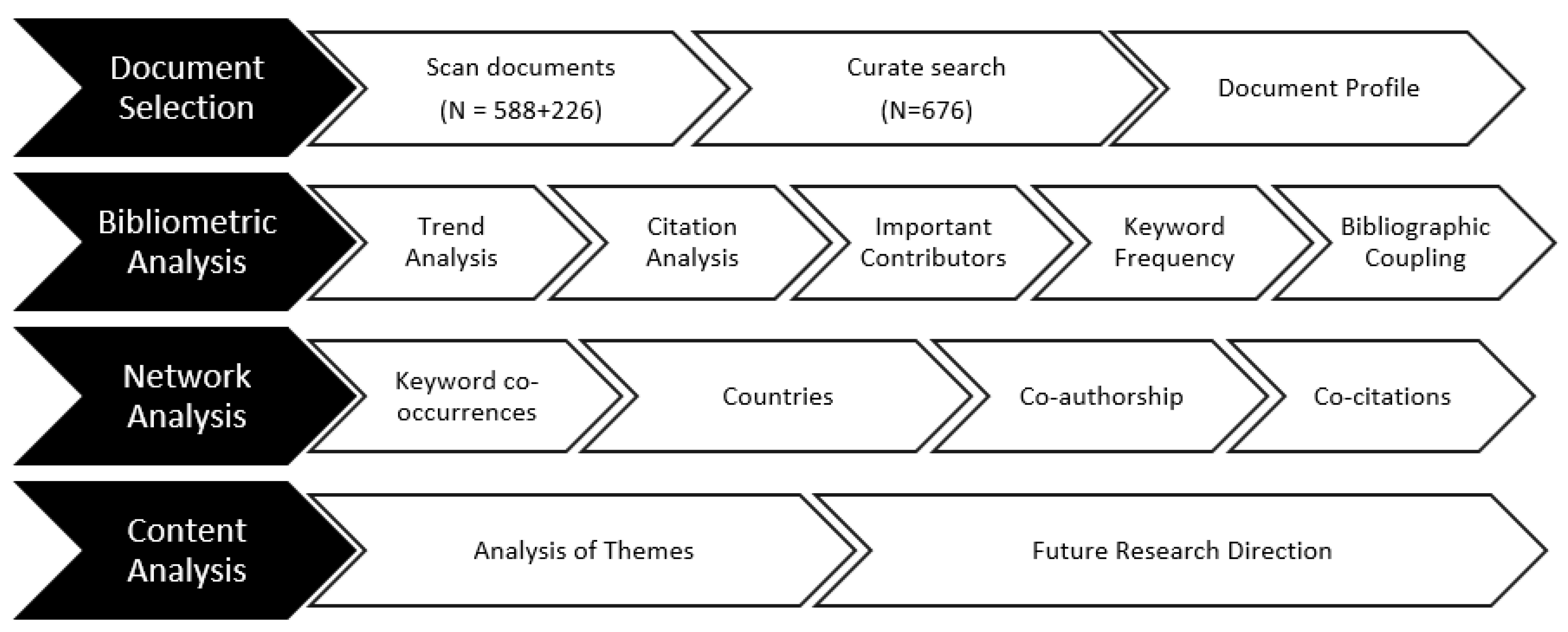
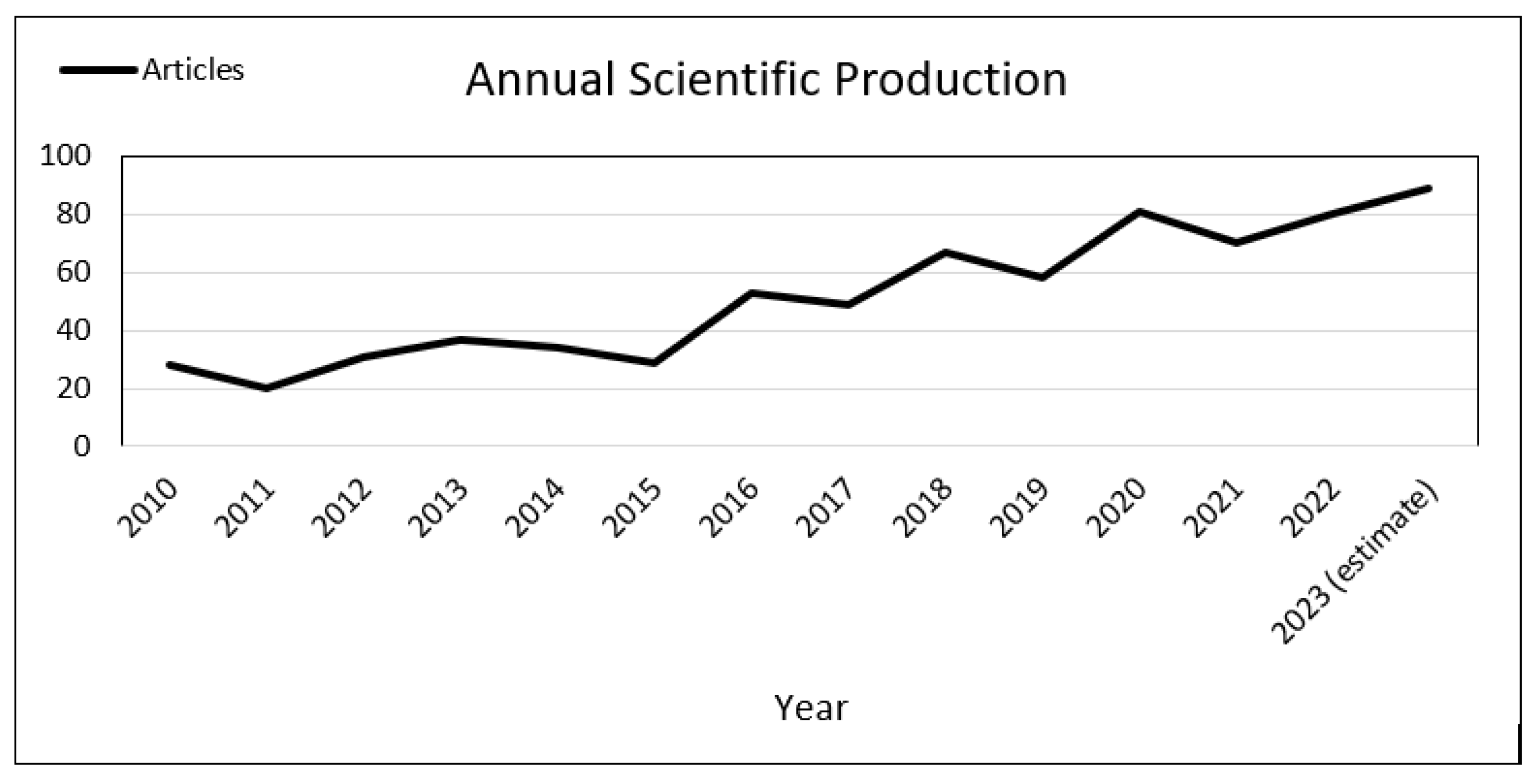


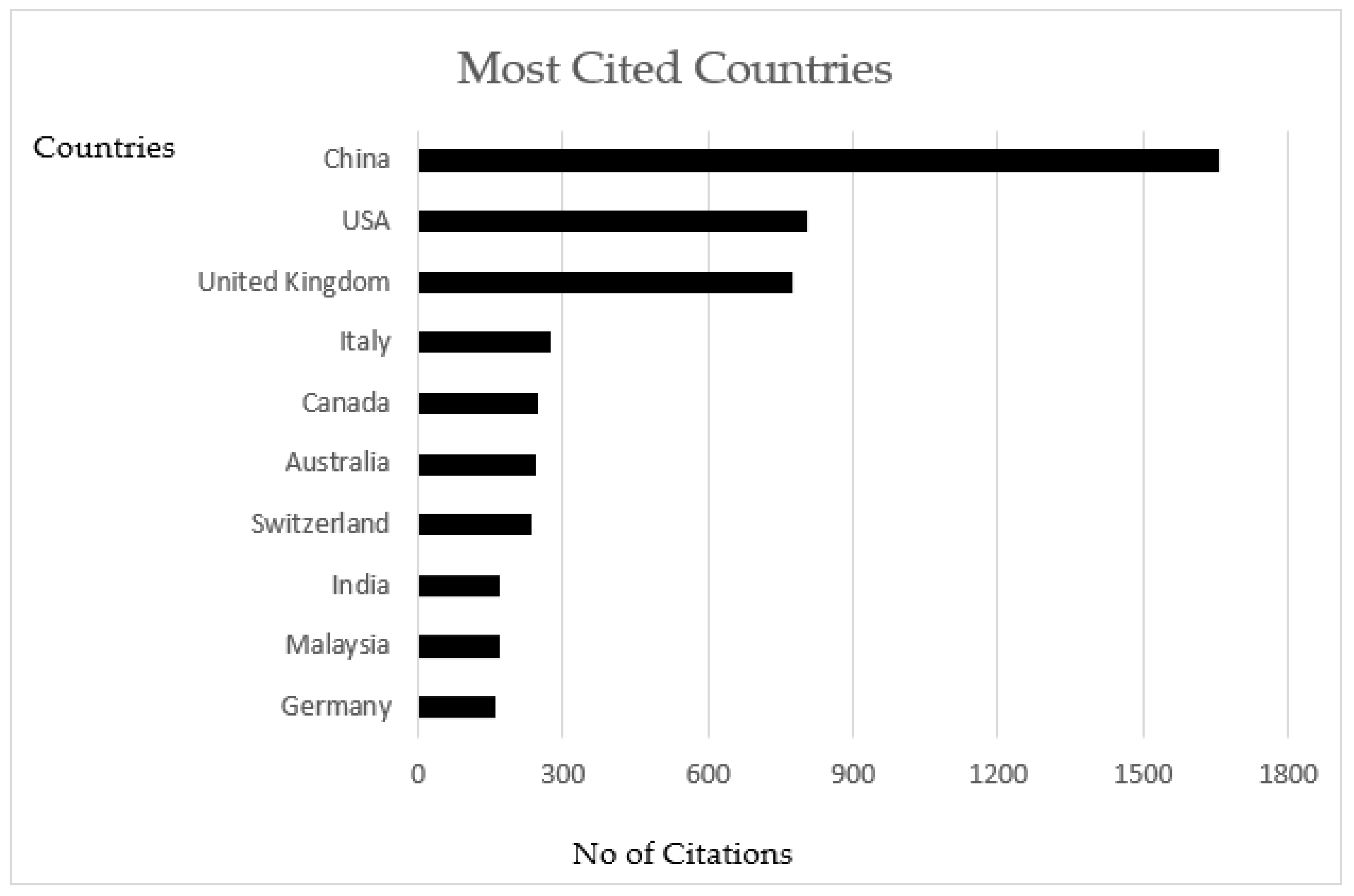
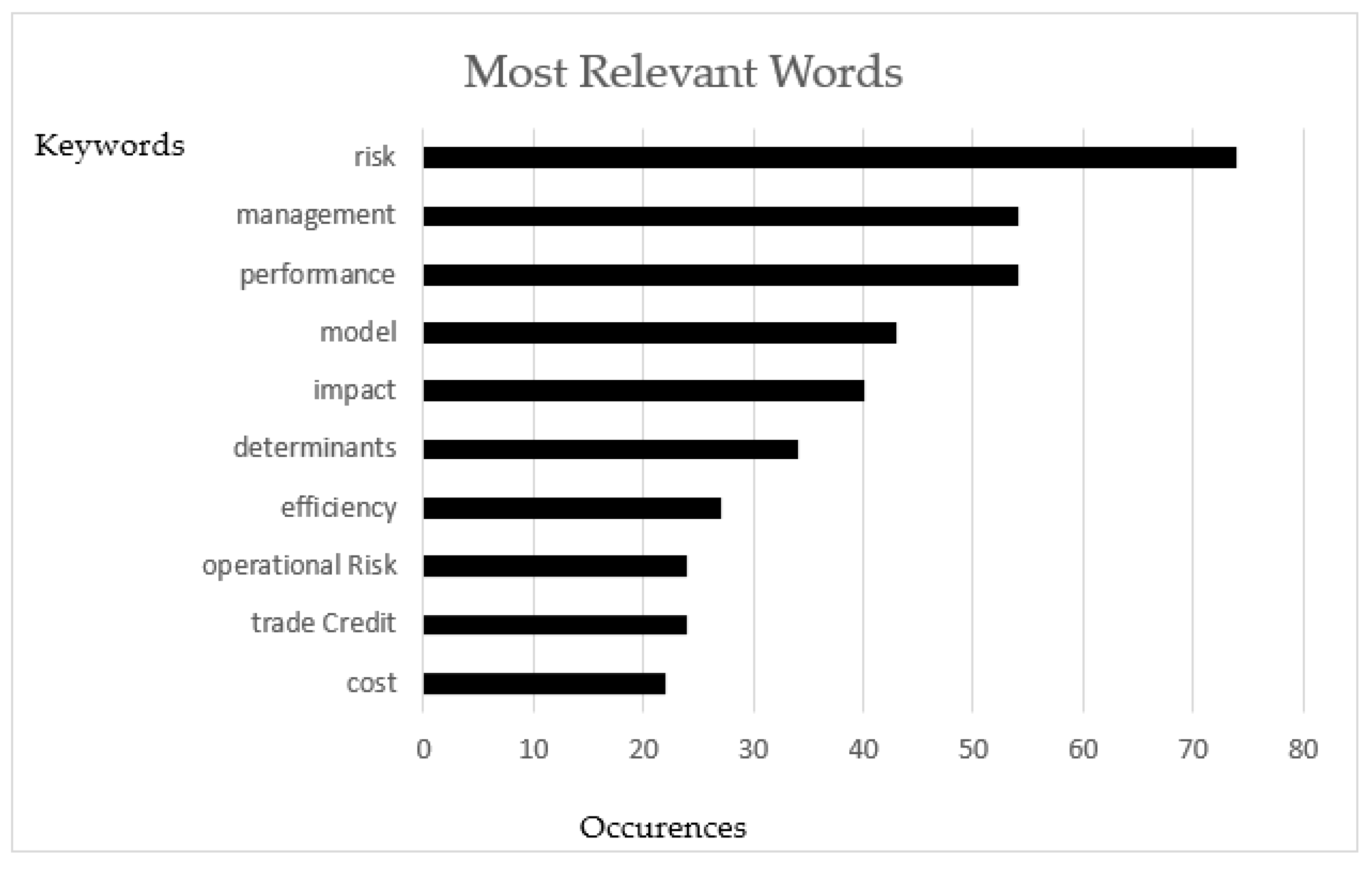


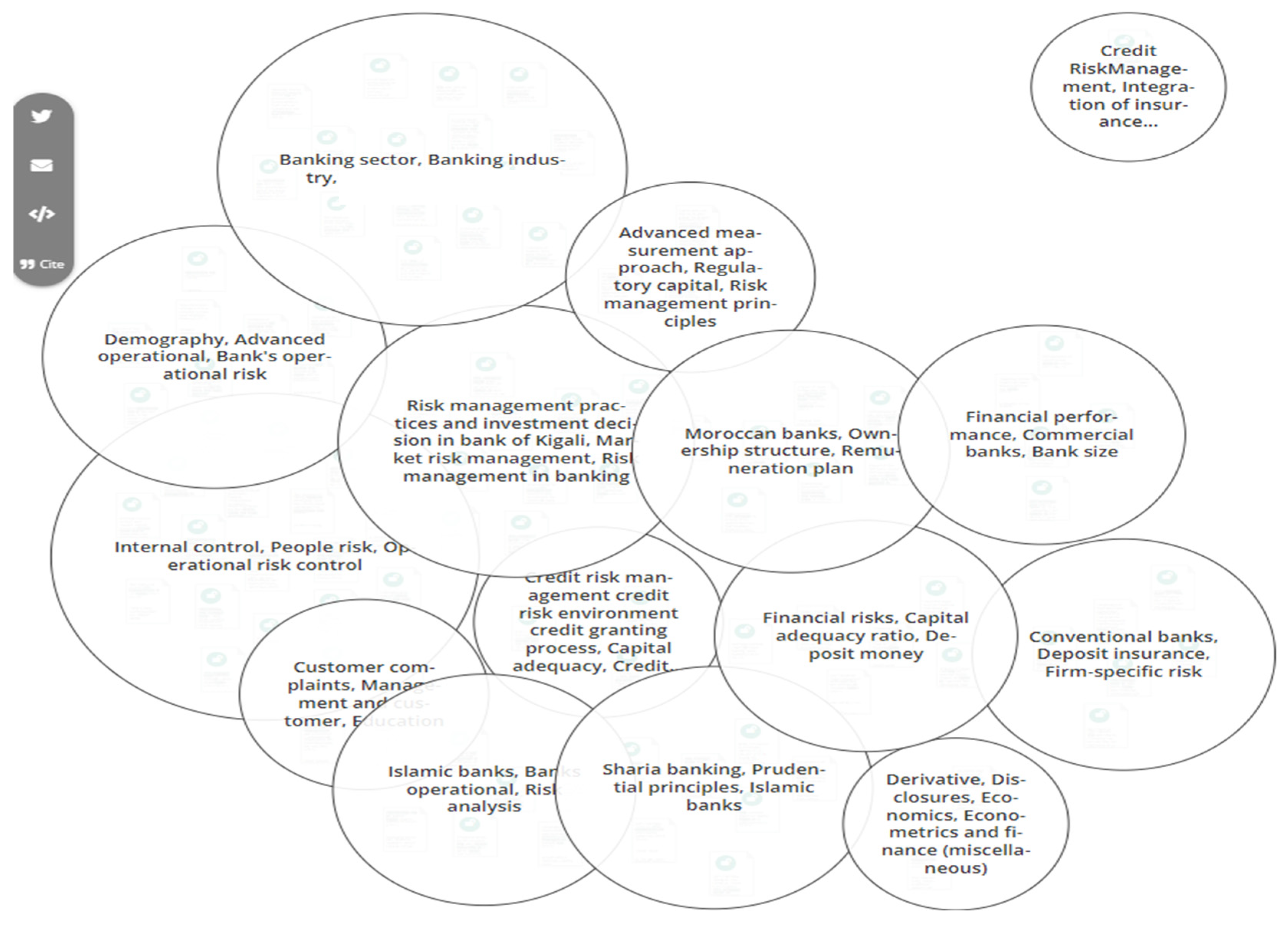
| Research Question | Purpose | |
|---|---|---|
| RQ1 | What are the most relevant and important keywords that can be used by future researchers to search for relevant articles in the existing literature in this domain? | To assist researchers in searching relevant articles based on keyword searches (Aria and Cuccurullo 2017). |
| RQ2 | What are the current themes in the existing literature that can be used for further deep-dive analysis and the identification of research gaps by researchers in the future? | To analyze popular themes in the current research area. Gaps in research can be identified based on a review of existing literature. |
| RQ3 | What are the emerging methods that can be used to perform a quick and effective structured literature review in the future? | This would help future researchers improve their productivity by performing faster and more effective structured literature reviews. |
| RQ4 | What are the areas that should be focused on for conducting future research in this domain? | The most important research question that provides direction to future researchers and opportunities for advancement in this field of study (Khanra et al. 2021). |
| Details | Outcome |
|---|---|
| Sources (journals, books, etc.) | 353 |
| DOCUMENT CONTENTS | |
| Keywords plus (ID) | 1443 |
| Author’s keywords (DE) | 2218 |
| AUTHOR COLLABORATION | |
| Single-authored docs | 117 |
| Co-authors per doc | 8.6 |
| International co-authorships % | 21.89 |
| Title of Paper | Field of Research | References | DOI | Total Citations (TC) |
|---|---|---|---|---|
| “Efficiency Measures of the Chinese Commercial Banking System Using an Additive Two-Stage DEA” | Bank efficiency | Wang et al. (2014) | 10.1016/j.omega.2013.09.005 | 235 |
| “Bank Governance, Regulation, Supervision, and Risk Reporting: Evidence from Operational Risk Disclosures in European Banks” | Inadequate governance and disclosures | Barakat and Hussainey (2013) | 10.1016/j.irfa.2013.07.002 | 123 |
| “Enterprise Risk Management: Coping with Model Risk in a Large Bank” | Model risk | Wu and Olson (2010) | 10.1057/jors.2008.144 | 114 |
| “Machine Learning in Banking Risk Management: A Literature Review” | Fraud risk | Leo et al. (2019) | 10.3390/risks7010029 | 105 |
| “Supply Chain Financing Using Blockchain: Impacts on Supply Chains Selling Fashionable Products” | Supply chain operational risk | Choi (2020) | 10.1007/s10479-020-03615-7 | 101 |
| “A Comprehensive Analysis of the Effects of Risk Measures on Bank Efficiency: Evidence from Emerging Asian Countries” | Relationship between risks and efficiency | Sun and Chang (2011) | 10.1016/j.jbankfin.2010.11.017 | 97 |
| “Operational risk and reputation in the financial industry” | Analysis of operational risk events | Gillet et al. (2010) | 10.1016/j.jbankfin.2009.07.020 | 86 |
| “Assessing the efficiency and total factor productivity growth of the banking industry: do environmental concerns matters?” | Environmental degradation | Shair et al. (2021) | 10.1007/s11356-020-11938-y | 74 |
| “Risk in Islamic banking and corporate governance” | Corporate governance | Safiullah and Shamsuddin (2018) | 10.1016/j.pacfin.2017.12.008 | 67 |
| “The determinants of reputational risk in the banking sector” | Reputation risk | Fiordelisi et al. (2013) | 10.1016/j.jbankfin.2012.04.021 | 62 |
| Journal | Total Link Strength |
|---|---|
| European Journal of Operational Research | 6630 |
| Journal of Operational Risk | 3666 |
| Journal of the Operational Research Society | 2550 |
| International Transactions in Operational Research | 1860 |
| Journal of Risk and Financial Management | 1570 |
| Journal of Banking & Finance | 1272 |
| Journal of Asian Finance Economics and Business | 1120 |
| Operational Risk Management in Banks: Regulatory, Organizational and Strategic Issues | 1120 |
| International Review of Financial Analysis | 815 |
| Financial and Credit Activity—Problems of Theory and Practice | 810 |
| Risk Analysis | Primary Data Source | Analysis Method/Tool | References |
|---|---|---|---|
| Inadequate governance and disclosures | Review of risk disclosures | Multivariate regression | Barakat and Hussainey (2013) |
| Fraud risk | Literature review: Machine learning | Evaluation of machine learning | Leo et al. (2019) |
| Relationship between risks and efficiency | Data from Bankscope database | Stochastic frontier approach and data envelopment analysis using Stata 9.0 software | Sun and Chang (2011) |
| Analysis of operational risk events | Data from the FIRST database | Analysis of returns around the operational loss event date | Gillet et al. (2010) |
| Environmental degradation | Data on efficiency and total factor productivity | Data envelopment analysis | Shair et al. (2021) |
| Corporate governance | Data from Bankscope database | Multivariate regression | Safiullah and Shamsuddin (2018) |
| Reputation risk | Data on operational risk events | Multivariate regression | Fiordelisi et al. (2013) |
| Analysis of operational risk events | Data from the FIRST database | Multivariate regression | Wang and Hsu (2013) |
| Corporate governance | Analysis of various literature in this domain | Discussion/Review | Ginena (2014) |
| Integrated risk management | Market and credit loss returns | Time series, marginal loss return distributions and the copula parameters | Grundke (2010) |
| Systemic operational risk | Review of LIBOR manipulation | Discussion/Review of Systemic Operational Risks | McConnell (2013) |
| Relationship between risks and efficiency | Banking industry data | Stochastic frontier approach | Delis et al. (2017) |
| Determinants of risk disclosures | Annual reports of banks | Creation of Risk Disclosure Index | Nahar et al. (2016) |
| Reputation risk | Detailed academic analysis of these new insurance policies and conceptualization of reputation risk | Discussion/Review | Gatzert et al. (2016) |
| Systemic risk and financial contagion | Credit default swap data | Tlasso model | Torri et al. (2018) |
| Risk management committee determinants and consequences | 10-K Wizard keyword search on financial institutions | Probit regression model | Hines and Peters (2015) |
| Risk management and financial stability | Ratios calculated based on data from the State Bank of Pakistan | OLS regression Model | Hafiz et al. (2019) |
| Human operational risk management | Data on four random variable sets, i.e., demand, capacities, initial capability and operation efficiency | Stochastic programming techniques | Fragniere et al. (2010) |
| Business complexity and risk management | Data on operational risk events | Analysis of key contributing factors | Chernobai et al. (2011) |
| Information asymmetry | Analysis of operational announcements and their trades on the stock exchange | Information asymmetry model | Barakat et al. (2014) |
| Issues in operational risk capital modeling | Published literature and author’s experience | Discussion/Review | Chaudhury (2010) |
| Cybersecurity hazards | Literature review | Systematic Review | Uddin et al. (2020) |
| Barriers to the implementation of Basel regulations | Survey questionnaire | Logistic Regression Model | Masood and Fry (2012) |
| Relationship between credit risk and operational risk | Survey questionnaire | PLS-SEM model | Rehman et al. (2020) |
| Estimation of maximum potential losses | Digital banking transaction risk data due to downtime | Extreme Value at Risk | Saputra et al. (2022) |
Disclaimer/Publisher’s Note: The statements, opinions and data contained in all publications are solely those of the individual author(s) and contributor(s) and not of MDPI and/or the editor(s). MDPI and/or the editor(s) disclaim responsibility for any injury to people or property resulting from any ideas, methods, instructions or products referred to in the content. |
© 2024 by the authors. Licensee MDPI, Basel, Switzerland. This article is an open access article distributed under the terms and conditions of the Creative Commons Attribution (CC BY) license (https://creativecommons.org/licenses/by/4.0/).
Share and Cite
Jadwani, B.; Parkhi, S.; Mitra, P.K. Operational Risk Management in Banks: A Bibliometric Analysis and Opportunities for Future Research. J. Risk Financial Manag. 2024, 17, 95. https://doi.org/10.3390/jrfm17030095
Jadwani B, Parkhi S, Mitra PK. Operational Risk Management in Banks: A Bibliometric Analysis and Opportunities for Future Research. Journal of Risk and Financial Management. 2024; 17(3):95. https://doi.org/10.3390/jrfm17030095
Chicago/Turabian StyleJadwani, Barkha, Shilpa Parkhi, and Pradip Kumar Mitra. 2024. "Operational Risk Management in Banks: A Bibliometric Analysis and Opportunities for Future Research" Journal of Risk and Financial Management 17, no. 3: 95. https://doi.org/10.3390/jrfm17030095
APA StyleJadwani, B., Parkhi, S., & Mitra, P. K. (2024). Operational Risk Management in Banks: A Bibliometric Analysis and Opportunities for Future Research. Journal of Risk and Financial Management, 17(3), 95. https://doi.org/10.3390/jrfm17030095






